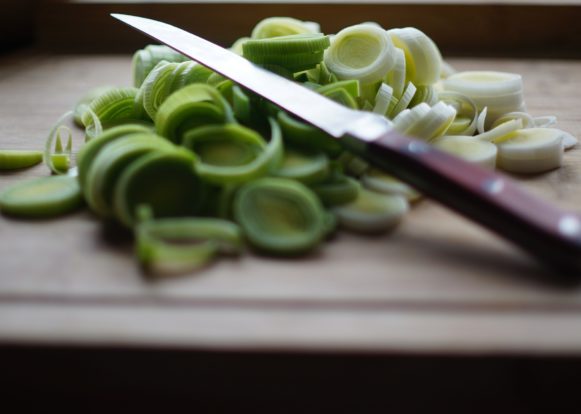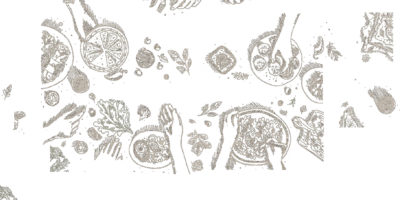Lilith Feature
When Women Feed Women
For many of the past 20 years, I’ve celebrated my birthday by inviting about a dozen or so of the women closest to me to come for dinner and an evening together, starting well before I became a chef and food writer professionally. This past May, with pandemic-induced caution, we were just five gathered outside on my deck. Still, l lingered over planning and preparing all the dishes for the special meal, knowing my friends would appreciate the fresh, healthy dishes and interesting flavors.
On a warm evening, I started us with prosecco, spicy guacamole with homemade corn chips, smoky baba ghanouj, crispy cucumber and pepper slices and seedy gluten-free crackers. The main course? Watermelon with feta, kalamata olives and mint with a balsamic drizzle. A platter of grilled zucchini, asparagus, spring onions and artichoke bottoms on a bed of arugula topped with fava beans, toasted pumpkin seeds and a light vinaigrette. The dish that meant the most to me came from my Sephardic heritage—lemony yaprakas (aka dolmades), stuffed grape leaves I made with wild leaves I had foraged in a D.C. park, blanched and rolled with rice, barberries, pistachio and dill stuffing. I shared my friends’ pleasure as we ate, talked, laughed and felt grateful to be together.
My birthday dinners are like many of the times women come together—a celebration, book group, mahjong game, volunteer meeting or just to catch up—updated versions, I suppose, of the unfortunately maligned old-fashioned coffee klatch that kept women connected with one another amid busy lives. Along with the conversation, there’s always (for those of us lucky enough to be able to host others) the food.
Over the past several months, I’ve been thinking about what I prepare for a gathering of women, perhaps because I feel acutely the loss of so many occasions to gather in person. When we come together just with other women, what do we feed each other? What’s special about this food? Is there more care or intentionality in the hope that we’ll delight our guests?What’s different from what we serve when men are also present? As I posed these questions, I suddenly realized that what I was really looking to understand were the special traditions around the food at women-only gatherings and what we reveal about ourselves in what we serve other women.
I started by checking Jewish sources for references to women feeding women. The only relevant story I could remember was of Ruth gleaning grain to feed Naomi, but that story quickly turns to Boaz and…well, it’s not really about the food. So, I asked Rabbi Gilah Langner, a friend who has been to many of my gatherings of women, to enlighten me about what I’d been missing in stories in the Torah or Talmud of what women fed to other women.
“How would the men who wrote the Torah know anything about what the women did together?” she responded. “Their associations of women and food are most often about wooing women, or fertility, or even harm being done to men by women like Judith.” Right, Judith. Her story isn’t included in the Torah, although you may remember that she saved her Israelite people from the Assyrians by feeding the enemy general salty cheese, then wine to quench his thirst—lots of wine. He got drunk, fell into a deep sleep, and didn’t wake up when she entered his tent and cut off his head. Not really the food story I was looking for.
For a more contemporary view, I turned to Dr. Pamela Nadell, author of America’s Jewish Women: A History from Colonial Times to Today. Her impression? That what women cook for each other is different from dishes they prepare for men. “Women don’t cook steaks for other women. It’s a different kind of meal…salads and vegetables and fruit. If there’s meat, it’s likely to be something like chicken salad.” These healthier foods, she explained, reflect women’s concerns about body image and weight. In fact, many second-wave feminist publications treated food as toxic, bound to the too common affliction of eating disorders, and also to the idea of social norms restricting women to cooking and childrearing. Lilith magazine was an early leader in connecting Jewish women and food in positive ways, as a source of pleasure and transmission of cultural and family identity. Today, happily, women are rightfully linked to food in those more positive ways.
Einat Admony, author (Balaboosta, Shuk) and chef-owner of the restaurants Balaboosta in New York and Taïm in NYC and D.C., is renowned for helping to popularize Israeli food in the U.S. and for hosting gatherings in her Brooklyn home. “I have always loved inviting other women in the culinary industry over for dinner, and often ask them to bring a dish that represents them. It’s a great way to get conversation started and get to know each other.” This is something I find true as well—sharing food opens us up. Einat also cooks dishes that represent her heritage, so “they can have a glimpse of who I am as well—hand-rolled couscous and chicken tagine, or ghormeh sabzi (a Persian herb stew made with lamb or beef).”
Generalizations about serving women lighter dishes seem to fall away when the food has special meaning and history. Admony is doing what women throughout history have done— transmitting identity and culture through food. My ancestors, women forced by the Inquisition to flee Iberia starting in the late 15th Century, carried with them the recipes and foodways of the Sephardic Jews, dishes like quajado (kuajado, cuajado, or frittada de prassa in Ladino, their language based on medieval Spanish). This Sephardic vegetable-egg casserole was considered such a Jewish dish that it became a substantial part of damning Inquisition testimony identifying who was Jewish. Women were jailed, tortured and even killed for making it. Yet women kept making quajado, and it has survived for over five centuries so that today we know and prepare this dish, which has great meaning for me. It’s one of my favorites to serve at gatherings of women and to bring to friends with new babies as well as for holidays, Shabbat and even everyday meals when some extra nourishment of soul as well as body is needed.
Since there are differences in the food based on personal connection and heritage, are there differences also between the food we serve to mixed-gender groups versus all-women? I think about feeding my son, Sam, and his friends as boys and now young men: large quantities of food with lots of carbs. And in his teen years, nothing made Sam happier than throwing steaks on the grill with his friends, even through his rainy 15th birthday celebration.
I was curious to learn from Gilah Langner’s observations as a leader and participant in many Jewish study groups. After some thought, she said she realized the coed groups, often majority male, tended toward just a few bowls of snacks—like nuts or pretzels. By contrast, at women’s study groups (at least pre-COVID), the host put time and effort into the food. “The spreads were unbelievable! In one group, there was even gentle competition about what each woman would put out, like a special cheese, or a different interesting salad.”
Noting gendered approaches to food, Pamela Nadell pointed out that before an Orthodox wedding, in the bride’s room, there’s lots of food for the women attendants, an expression of care and love. For the men preparing the groom for the ceremony, it’s all about toasting the groom with alcohol.
In my explorations of women-only gatherings and food traditions, I naturally came to mahjong. Immigrants to the U.S. in the 1920s created their own adaptation of the original Chinese game. In fact, mahjong became coded as a Jewish women’s game even as our immigrant grandparents and great-grandparents strove to fit into their new American homes.
When Jean Graubart moved from the Washington, D.C., area to Alameda, California, eight years ago, she knew she wouldn’t feel really at home until she found a mahjong group. Now, some of her closest friends are the five women she played with every week until the pandemic. In the past few months they’ve taken up playing in person again, now outdoors. Pre-COVID, the host would set up a buffet featuring some of the same foods each week—olives, hummus, fresh vegetables and fruit, cookies or cake, and always the host’s favorite candy. Graubart serves her crowd-pleasing creation: fresh strawberries dipped in storebought lemon curd, which the women feel is a special treat.
And I still remember what my mother served—every time— when it was her turn to host her regular mahjong game at our home in Denver in the 1950s and 1960s. I’d fall asleep to the click-click of the domino-like tiles and calls of “bam,” “dot” or “crack,” knowing that the next day there would be leftovers of her game-day Entenmann’s coffee cake, nonpareils and chocolate-covered nuts from the Brach’s Bridge Mix.
A few years ago, when I finally learned to play mahjong myself, I became part of a group where the treats are fruit, roasted nuts, popcorn and nice cheeses. We’re also likely to have one, maybe two, home-baked treats, taking care that there are gluten-free options for the person with celiac disease. Unlike Graubart’s California group that eats only when they aren’t playing, my group loves to eat as we play, a good excuse for slowing down the game when you need time to think. The first time I hosted, we used my mother’s mahjong set from the 1950s, tiles yellowed by time, and, in addition to our usual fruit-nuts-cheese, I served nonpareils and coffee cake. However, instead of buying an Entenmann’s cake, I made one from scratch—updated to gluten-free, but carrying on my mother’s tradition.
What are we saying about ourselves by what we serve other women?
It seems that food traditions develop in women’s groups that meet regularly, even if the food is simple. We figure out what pleases the others, and we put it on replay, finding comfort in caring for each other. But what about the times we have a special women’s gathering? What do we choose to serve, and why? How does the food add to the meaning of the gathering?
A few years ago, when a dear friend agreed to let me host a 55th birthday dinner for her and the women closest to her, I created a meal of some of her favorites. It was my special gift to her. She liked Middle Eastern foods and flavors, so her menu started with whipped lemon feta with fresh pita and crackers, stuffed grape leaves, assorted olives and some of my homemade pickles.
We moved on to gazpacho, which had been making regular appearances at her home since I had taught her to make it some years before. Salmon was roasted with everything seasoning (put on her regular dinner rotation after that as one of the few ways her 10-year-old son would eat fish) served with tzatziki, as well as Moroccan carrots for the two years she had lived in Morocco, grilled zucchini and a kale-quinoa salad with apricots, green onions and roasted almonds, another favorite. Then fruit, ice cream and birthday cake complete with candles, of course.
All of us at this “girlfriends’ celebration,” including my friend’s sister who’d come in from Philadelphia, knew too well the poignant significance of a festive birthday dinner for a woman who for the past four years had been fighting an aggressive cancer. Even though we didn’t all know each other when we arrived, a dozen women sat around one big square table and talked for hours. The food, as well as our relationships to our special friend, quickly connected us. And when she died the following summer, six weeks before celebrating another birthday, we came together again to cry, to comfort each other, and to feed her family gathered for the shiva.
Food is a marker of who we are—our individual, ethnic, Jewish and gender identities. Why and when women gather helps determine what food we serve and how we serve it. The choices we make also express our care for other women and our pleasure in their pleasure. When women gather, we nourish our psyches and hearts and spirits as well as our bodies.
Between Rosh Hashanah and Yom Kippur this year, while the heat of summer was still upon us, I asked three girlfriends to join me for dinner on my deck to connect during that deeply significant spiritual time. Lovingly, I planned and prepared a meal that we would all enjoy and that featured the late-summer bounty, some from my deck garden. Even the highly allergic friend, who nearly always has to bring her own food, could eat without sacrificing flavor and delight. We started with appetizers at dusk—feta and olives marinated in olive oil with garlic, lemon and my own za’atar mix; smoky baba ghanouj; cut-up fresh vegetables and assorted crackers. We moved on to gluten-free tagliatelle with roasted cherry tomatoes and some of my latest batch of no-cheese pesto (Parmesan on the side). A large platter held grilled asparagus, slices of zucchini and green beans on lemony arugula with a drizzle of good olive oil and scattering of fennel flowers. As the stars came out we lit the many candles I’d set out, creating a magical atmosphere as we lingered over the special meal I was happy I’d fixed just for them.
Susan Barocas is a writer, chef and cooking instructor with a passion for healthy, no-waste cooking and Jewish food, especially Sephardic history, cultures and cuisines.






